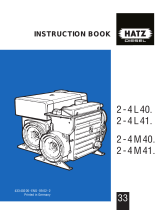
Table of contents
5100009744IVZ.fm 3
1 Preface ....................................................................................................................................5
2 Introduction ............................................................................................................................6
2.1 Using the manual......................................................................................................................... 6
2.2 Storage location of the manual.................................................................................................... 6
2.3 Accident prevention regulations................................................................................................... 6
2.4 More information.......................................................................................................................... 6
2.5 Target group................................................................................................................................ 6
2.6 Explanation of symbols................................................................................................................ 6
2.7 Wacker Neuson Contact partner ................................................................................................. 7
2.8 Disclaimer.................................................................................................................................... 7
2.9 Product identification of the machine........................................................................................... 7
3 Security ..................................................................................................................................8
3.1 Policy........................................................................................................................................... 8
3.2 Areas of responsibility of the operator......................................................................................... 8
3.3 Operator responsibilities.............................................................................................................. 9
3.4 Personnel qualification................................................................................................................. 9
3.5 General sources of danger.......................................................................................................... 9
3.6 General safety instructions.......................................................................................................... 9
3.7 Specific safety instructions – Vibratory plates ........................................................................... 10
3.8 General safety instructions - Combustion engines.................................................................... 11
3.9 General safety instructions – fuel, lubricants and coolants........................................................ 11
3.10 General safety instructions – starter batteries........................................................................... 11
3.11 Maintenance.............................................................................................................................. 12
3.12 Personal Protective Equipment ................................................................................................. 12
3.13 Safety devices ........................................................................................................................... 13
3.14 Behavior in dangerous situations............................................................................................... 13
4 Safety and information labels ............................................................................................14
5 Setup and function ..............................................................................................................16
5.1 Standard package ..................................................................................................................... 16
5.2 Application areas....................................................................................................................... 16
5.3 Short description........................................................................................................................ 16
5.4 Versions..................................................................................................................................... 17
6 Components and operator's controls ................................................................................18
6.1 Components .............................................................................................................................. 18
6.2 Operator's controls .................................................................................................................... 19
7 Transport ..............................................................................................................................20
7.1 Loading and transport................................................................................................................ 20
8 Operation and use ...............................................................................................................22
8.1 Before commissioning ............................................................................................................... 22
8.2 Notes about operation ............................................................................................................... 22
8.3 Commissioning.......................................................................................................................... 23
8.4 Operation................................................................................................................................... 27
8.5 Decommissioning ...................................................................................................................... 28
9 Maintenance .........................................................................................................................30
9.1 Maintenance table ..................................................................................................................... 31
9.2 Maintenance jobs....................................................................................................................... 31
10 Troubleshooting ..................................................................................................................38
10.1 Fault table.................................................................................................................................. 38
10.2 Perform jump start with donor starter battery ............................................................................ 38
Inhalt





























